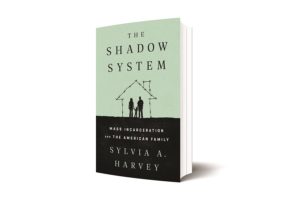Sylvia A. Harvey, in her book The Shadow System: Mass Incarceration and the American Family, offers a crash course on the gruesome realities of American prisons. Beginning with her own family history, Harvey humanizes her overview by showing how those in contact with the criminal justice system are affected by its unjust policies. She focuses largely on the immediate families of inmates, arguing that “structural inequality, biased legislation, and racism ensure parental incarceration continues to hit poor and racial minorities the hardest,” and that “all families, in different ways, are ripped apart at the seams.”
Through the lives and loved ones of three incarcerated parents — Randall, William, and Dawn — Harvey tackles a broad range of issues, from rural opioid use to the school-to-prison pipeline. The book includes intimate scenes of William and his wife, Ruth, on their weekly Saturday visits, and a compassionate account of Dawn’s childhood struggles and her oscillations, as an adult, between being a hardworking single mother and an erratic drug user. But Harvey never rests on these personal accounts too long, constantly forcing readers to imagine the stories of her sympathetic subjects played out countless times throughout the country. Woven into the three family narratives are hundreds more examples of the prison system’s expansion and inequity.

A decade after the publication of Michelle Alexander’s groundbreaking book, The New Jim Crow: Mass Incarceration in the Age of Colorblindness, many Americans have become familiar with the injustices of the prison system, and clear-eyed about its unequal treatment of people of color. But even at a time of widespread support for Black Lives Matter following George Floyd’s murder on May 25 by Minneapolis police, the statistics that describe the prison industrial complex bear repeating.
In the U.S. in 2010, 1.8 percent of white children, 3.5 percent of Hispanic children, and a shocking 11.4 percent of black children had at least one incarcerated parent. Incarceration rates for women increased from 1980 to 2017 by 700 percent. Since 1984, the number of inmates serving sentences of 50 years or longer has more than quadrupled, and it continues to grow, despite the dramatic decline in serious violent crime over the past 20 years. More than half of all people serving these harshest sentences are black, and in Mississippi, Alabama, Georgia, Illinois, Louisiana, Maryland, and South Carolina, two thirds are.
Throughout her book, Harvey compellingly argues that the U.S. criminal justice system is broken and bloated, and that it has not always been this way. The relatively recent growth of the prison population, the evils of for-profit prisons, and staggering recidivism rates all lead to the conclusion that the system we have made can and should be unmade. But Harvey will not be the one drawing the blueprint.
Published in April, just weeks before “defund the police” became fodder for bumper stickers, The Shadow System’s conclusion does not reimagine American law enforcement. Instead, it makes such commonsense suggestions as reducing cash bail, lowering maximum and blind minimum sentences, and eliminating “three strikes” and “truth in sentencing” laws, which have greatly extended the length of prison terms.
Harvey, who is too close to step away from the immediate needs of those affected, advocates “government-funded policies, programs and practices that help mitigate the collateral effects of mass incarceration. These families need support in maintaining their connections with their incarcerated family member. They need visitation policies that are child friendly and offer sufficient time for bonding. The trend for cutting in-person visits in favor of video visits should be curtailed. Families should not have to travel eight hours to see their family member, and they shouldn’t have to choose between dinner and two collect phone calls.”
Like the author, I was once the child of a prisoner. If you had asked my 13-year-old self what “prison reform” should look like, I’d have told you that the dress code for visitors could use some work. I desperately wanted to wear sweatpants on those three-hour commutes. By the time I was 15, I was concerned about the amount of money it required to stay in touch with my mother and angered by stories of other inmates whose families simply could not make it work. My mother and I wrote letters to policy makers about work release programs and community college classes. She had to fight for a spot in a substance abuse course, fight for the dentist to treat her gnarly case of gingivitis. Even from a place of relative privilege, we were so consumed by the system we had that we couldn’t imagine the one we wanted.

Harvey acknowledges this tradeoff between evaluating the situation and fixing it. Speaking of her formerly incarcerated father, she writes that he “reminded me that my job was to report what I found and to share those accounts, not internalize them, and definitely not to carry the burden of finding the solutions.”
Harvey’s reporting may, at times, lack subtlety. But there is often no other way to describe gross injustice: in the harsh sentencing of William’s son Naeem, and Randall’s careless transfer to an institution eight hours away from his young daughter, the reader is reminded that America’s criminal justice system always lacks subtlety. As expressed by her father, the author’s role here is not to break ground. Her mission is to pick up the gravel bits smashed before her and put them on display. Again, and again.
This book is not an abolitionist introduction to the current moment. Read your Angela Davis for that. But if you’re playing catch up, looking for some background on the conversations happening throughout the country right now, The Shadow System is a moving portrait of three families and the chains that hold them to a broken system.
Olivia Weeks’s summer fellowship with the Independent is supported by the Harvard Alumni Association and the Harvard Club of Cape Cod.



